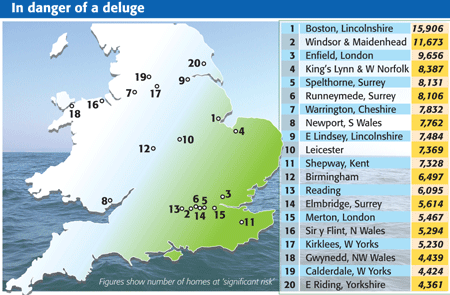Why you must check your flood risk
If you live or are moving to an area at risk of flooding, getting insurance can be expensive or, in some cases, impossible. We reveal how to check your risk level and where to get the best protection.
Last summer's floods in the Thames Valley provided some of the starkest images of natural disaster that Britain has seen in recent years residents wading through the streets, homes ruined by muddy water, furniture floating through town. Fourteen people died and more than £2bn worth of damage was caused.
But it seems Gordon Brown had his eyes closed throughout the entire disaster. The evidence of this is that his Government's plan to build three million new homes around the UK by 2020 has completely ignored one major problem: almost a third of these eco-friendly' houses will sit on plains that are at severe risk of flooding.
It's a pretty spectacular oversight on the part of the Government, particularly as the Chancellor, Alistair Darling, is also planning to set aside £2.15bn of taxpayers' money over the next three years to improve the UK's flood defences. Building houses at risk of flooding before you construct the flood protection itself is a pretty clear-cut case of putting the cart before the horse.
MoneyWeek
Subscribe to MoneyWeek today and get your first six magazine issues absolutely FREE

Sign up to Money Morning
Don't miss the latest investment and personal finances news, market analysis, plus money-saving tips with our free twice-daily newsletter
Don't miss the latest investment and personal finances news, market analysis, plus money-saving tips with our free twice-daily newsletter
The area on which the controversy centres is the Thames Estuary. In risk terms, you can divide the Thames Gateway into two parts, says Jane Milne of the Association of British Insurers (ABI), speaking to the journal Regeneration & Renewal. There's London itself, which, of course, has very high-quality flood protection. But then you have the area outside the M25, where the flooding infrastructure is not quite as sophisticated. Yet 13 major housing developments have been given the go-ahead in the past year, despite the protests of the Environment Agency.
Building homes on flood plains is bad enough. But to compound the problem, the ABI, angered by the inadequacy of Darling's flood defence payments, has warned that its members might refuse to cover housing in high-risk areas. As it stands, there is an agreement with the Government that insurance companies will insure those living in high-risk areas. These are defined as anywhere where there is a one in 75 chance, or greater, of flooding in any given year. Homeowners in such areas will be subject to higher premiums and excess charges, but at least they can get cover. However, this only stands for areas where the Government is investing in flood defences, notes Myra Butterworth in The Sunday Telegraph otherwise insurance will be offered on an "ad-hoc basis", says the ABI.
And with the average cost of settling a claim for flooding now standing at £70,000 to £200,000 per household an unsustainable burden for the insurance industry, according to Richard Mason of Moneysupermarket.com more and more insurers may simply refuse cover.
Even if you can secure insurance, with weather forecasters predicting an increase in river, sea and drainage flooding as a result of climate change, such floods are going to happen time and time again. And once your home has flooded once, finding affordable insurance to keep it covered could be nigh-on impossible. According to the ABI, growing numbers of houses will be "unsaleable, uninsurable and uninhabitable" if building in these areas continues.
So if you are planning to buy a property (which we wouldn't advise in any case, given the current state of the market), do consider flood risk before doing so (see below for a list of the UK's top 20 flood-risk towns). You can also assess the risk to your property by typing in your postcode on the Environment Agency website, or by calling Floodline on 0845-988 1188.
What to do if you're at risk
If you do find that you're living in an area identified as a flood plain, for £25 the Environment Agency will supply a letter classifying the chance of flooding in your area for insurance purposes. This is useful if you feel the insurer is overestimating the risk of flooding for your property.
In terms of securing an insurance provider in London, for a three-bed semi with £35,000 in contents and a market value of £750,000, the cheapest annual insurance would cost you £108 with Yesinsurance.co.uk and £110 with Debenhams.
For those in York, for the same size house with a market value of £240,000, it's best to go with Churchill (£101) or Direct Line (£111). If you are unlucky enough to be caught in a flood, you're advised to include pictures in your insurance claim, and keep samples of carpets and skirting boards as evidence of their quality for replacement purposes.

Get the latest financial news, insights and expert analysis from our award-winning MoneyWeek team, to help you understand what really matters when it comes to your finances.
MoneyWeek is written by a team of experienced and award-winning journalists, plus expert columnists. As well as daily digital news and features, MoneyWeek also publishes a weekly magazine, covering investing and personal finance. From share tips, pensions, gold to practical investment tips - we provide a round-up to help you make money and keep it.
-
 Why Trustpilot is a stock to watch for e-commerce exposure
Why Trustpilot is a stock to watch for e-commerce exposureTrustpilot has built a defensible position in one of the most critical areas of the internet: the infrastructure of trust, says Jamie Ward
-
 Tetragon Financial: An investment trust with stellar returns
Tetragon Financial: An investment trust with stellar returnsTetragon Financial has performed very well, but it won't appeal to most investors – there are clear reasons for the huge discount, says Rupert Hargreaves

